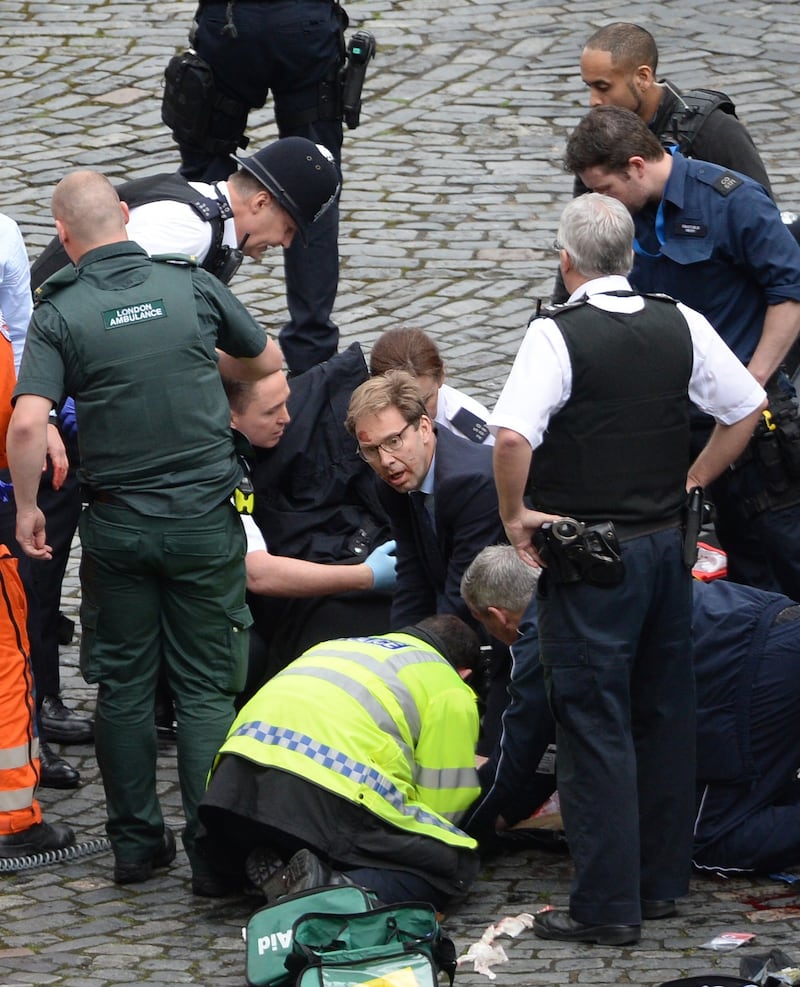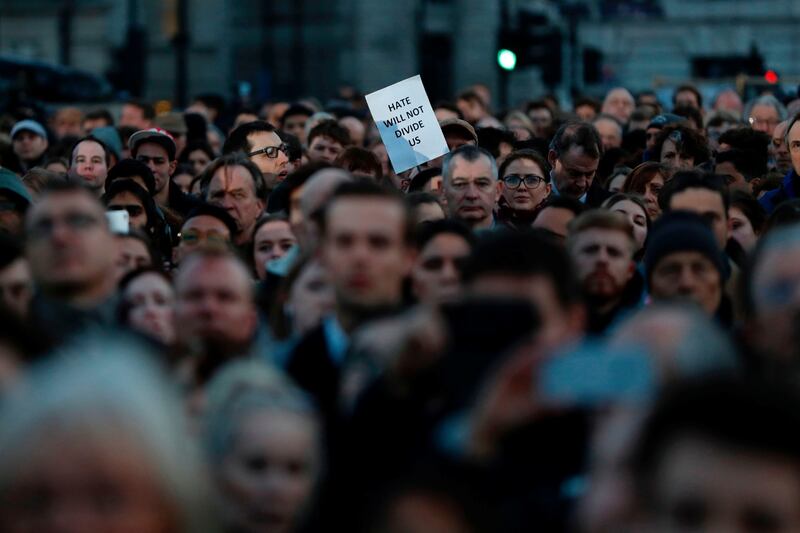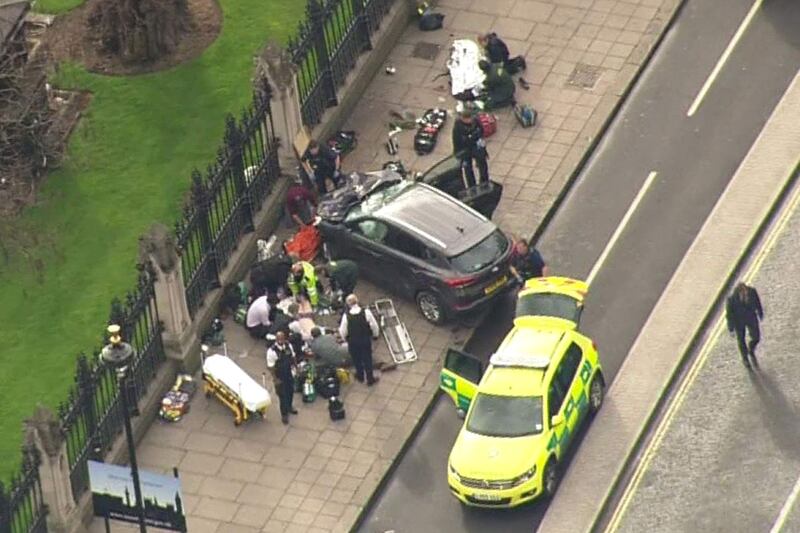On Thursday morning, 18 hours after the Westminster attack, a large area around the Houses of Parliament remained cordoned off to everyone except police and holders of parliamentary passes. The walk along Millbank from Lambeth Bridge was eerily quiet, with no traffic and few pedestrians.
Police sentries stood a few metres apart up to the entrance to the House of Lords, about 400 metres away, and each one said good morning as if it were the most ordinary morning in the world. At the other end of the parliamentary estate, close to Big Ben, a large courtyard was sealed off as a crime scene, with a white tent over the spot where PC Keith Palmer was murdered on Wednesday afternoon.
Khalid Masood's rampage lasted only a few minutes, but it left five dead and 40 injured, and put parliament into lockdown for five hours. It started on Westminster Bridge at about 2.40pm on Wednesday, when Masood drove a dark-grey Hyundai SUV on to a pavement at high speed, hitting dozens of pedestrians.

It almost lends you courage when you see people being calm and composed. Panic can be so contagious, but so can calm.
When the vehicle crashed into the railings of the Palace of Westminster the killer leaped out and, carrying a knife, ran through the gates into New Palace Yard, which houses the parliamentary underground car park. Palmer tried to stop him, but Masood stabbed the unarmed officer before being shot dead, reportedly by plain-clothes officers protecting the UK defence secretary, Michael Fallon.
Claire Tighe, who is from Mayo and runs the SDLP office at Westminster, was having lunch with a colleague on the terrace overlooking the River Thames.
“We heard an almighty sound coming from inside the canteen. It was just someone shouting, ‘Out, out’. It was said in such a way that it sounded like a fight,” she says. “We saw a flock of people running. Everyone abandoned the tables and ran.”

Bundled into a corridor with about 30 other frightened people, including two pregnant women, Tighe followed what was going on outside through social media. After a couple of hours her group was led first to Westminster Hall and then across the street to Westminster Abbey, to join hundreds of others. The abbey was freezing, but the atmosphere was calm as volunteers handed out cups of tea.
“There was a certain stoicism, and there’s something admirable about people’s acceptance of something like this happening and how they conduct themselves through it,” Tighe says. “It almost lends you courage when you see people being calm and composed. Panic can be so contagious, but so can calm.”
Display of normality
In the House of Commons on Thursday morning MPs put on an ostentatious display of normality as they returned to work. The chamber was packed for Theresa May’s statement on the attack, which paid tribute to Palmer and vowed that terrorism would not defeat democracy.
“I’m afraid this is going to be what they like to call ‘the House of Commons at its best’, which is usually nauseating,” the reporter next to me whispered.
It was not at all nauseating, but the debate reinforced Britain’s long-standing view of itself as plucky and a little bloody minded in the face of attack – the spirit of the Blitz. One MP quoted a sign said to have been written by a Tube worker and displayed at an Underground station: “All terrorists are politely reminded that THIS IS LONDON and whatever you do to us we will drink tea and jolly well carry on. Thank you,” it said. (The sign turned out to have been an online creation.)

If London was calm after Wednesday’s attack it was partly because it’s a city accustomed to terrorism, having endured IRA bombing campaigns before the Islamist threat emerged at the start of this century. London suffered its worst Islamist terrorist outrage 12 years ago, on July 7th, 2005, when a series of suicide bombers targeted civilians using public transport. Fifty-two people were killed and more than 700 were injured.
The security services had long been expecting an attack like Wednesday’s, which was similar to those in Nice and Berlin last year, when the killers also drove vehicles into pedestrians.
Since the 2005 attacks successive London governments have poured tens of millions of pounds into Prevent, a controversial programme involving local authorities, schools, prisons, mosques and community groups
"There have been a number of training exercises and different operations over the last five years. And they've been changing to accommodate the new threat of independent, lone-wolf, self-starter attacks like what we saw on Wednesday," Rebecca Skellett, of the Institute for Strategic Dialogue, says. "All aspects of London, from the fire brigade to police, to healthcare, to community policing, to local authorities, are part of a very solid infrastructure that was tried and tested numerous times for an event like this. So the response on Wednesday, turning around in eight minutes, was indicative of that level of preparedness."
The four Ps
After the 9/11 attacks, in 2001, the UK initiated a counterterrorism strategy called Contest, made up of four Ps: prepare for attacks, protect the public, pursue the attackers, and prevent their radicalisation in the first place. Since the 2005 attacks successive London governments have poured tens of millions of pounds into Prevent, a controversial programme with hundreds of schemes involving local authorities, schools, prisons, mosques and community groups.
Skellett runs the Strong Cities Network, a global network of mayors, municipal-level policymakers and practitioners to combat violent extremism. A former Prevent practitioner, she acknowledges that the programme has had problems and that it was initially conceived with too rigid a focus on security. But she claims that it has proven to be effective in halting people on their paths towards terrorism.
“There is an opportunity to intervene in somebody’s path, and actually a lot of the time that journey to terrorism can be based upon a series of exploitative measures,” she says. “It can be designed to manipulate somebody’s vulnerabilities, to making them placed in a position where violence is the only legitimate way to bring about change, be that political or other. So we’re in a position in the UK where there’s a very healthy public understanding that to become radicalised is actually a much more straightforward process than many other countries think of it as.”
Those regarded as being at risk of radicalisation can be referred to a programme called Channel, which uses religious experts, social workers and psychologists to counsel them in one-on-one sessions.

Under suspicion
Prevent’s critics say it has put entire Muslim communities under suspicion, as the slightest hint of radicalisation can lead to a referral to the programme. Skellet claims that safeguards are now in place to protect people from what she calls “unhealthy referrals” but insists that the programme must look at an individual’s long-term risks, even if there is no evidence that the person is likely to turn violent.
“It’s looking at an individual who might be engaging, sympathising or empathising with extremist literature, extremist groups, extremist recruiters. But it’s also looking at their families, their social networks, their economic situation, thinking about mental health issues,” she says. “The people working in Prevent are the unknown everyday heroes who change lives but the public don’t get to hear about that. For obvious reasons, individuals who have gone through Channel are not going to be happy to go on TV and tell people their stories.”
The moment you start to compromise on some of those civil liberties, for the sake of intrusive security surveillance, that will put more people into the hands of ideologies
London's mayor, Sadiq Khan, who is Muslim, says Britain's security services have foiled 13 terror plots in London during the past four years. But they did not stop Masood, who was born Adrian Russell Ajao, in Kent, and converted to Islam when he was an adult. May told MPs that MI5 investigated Masood a number of years ago in relation to violent extremism but said that he was seen as a "peripheral figure" who was not part of the intelligence picture more recently.
The UK’s security service employs about 4,000 people, so intelligence targets are categorised as “essential” or “desirable”, with only the essential ones automatically subject to surveillance. Masood’s success in killing and injuring so many people has been condemned as an intelligence failure, prompting calls for more armed police and more intrusive surveillance.
Skellett believes that, despite a recent rise in hate crimes and some baiting of Muslims in the popular press, London remains an unusually harmonious city with strong community relations and a shared determination to preserve civil liberties in the face of terror.
“The moment you start to compromise on some of those civil liberties, for the sake of intrusive security surveillance, that will put more people into the hands of ideologies which suggests there is a ‘them’ and ‘us’ in society and there is an enemy within, which I really hope won’t happen and I think certainly has not happened so far here,” she says. “But we shall see. Hopefully, people will remain calm and proportionate, because those are often the first two traits that people abandon in times of crisis.”




















